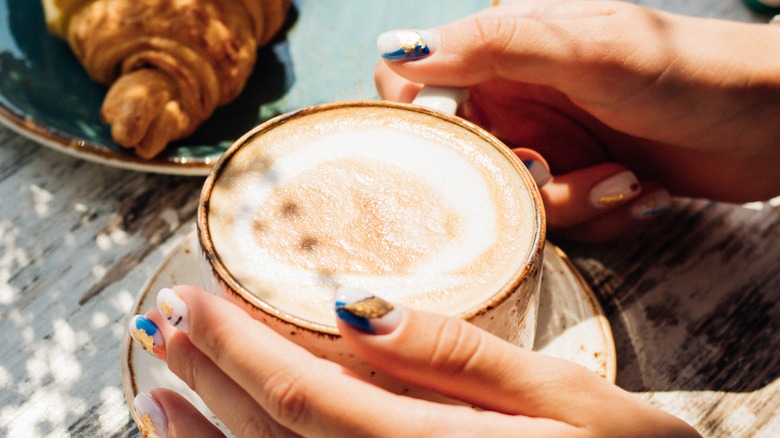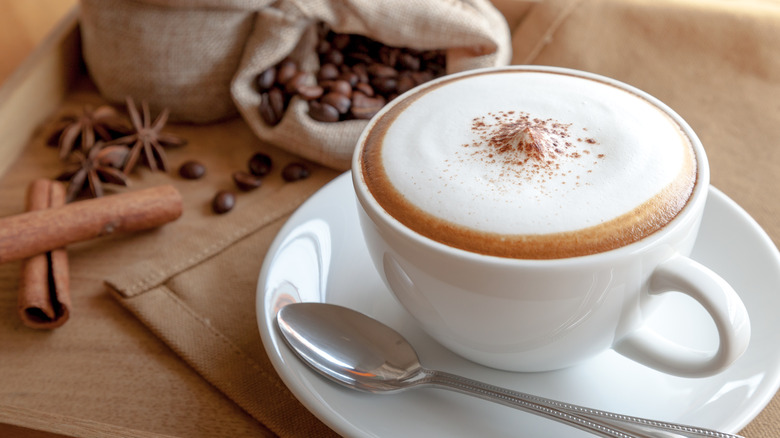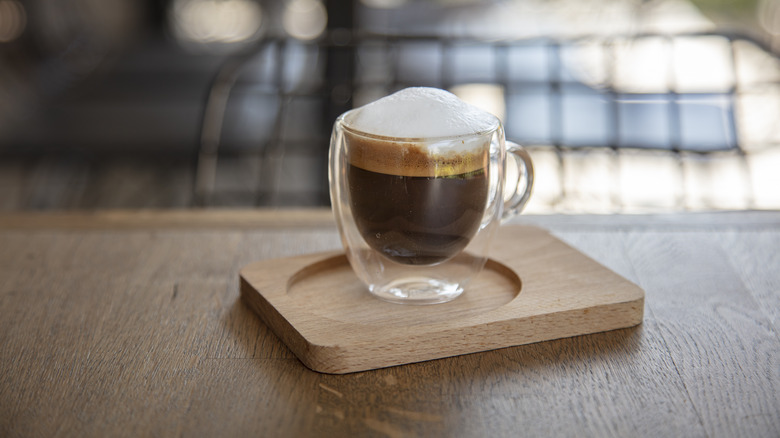What Makes A Cappuccino Different From A Macchiato?
Starbucks offers a menu item called a "Caramel Macchiato" made with vanilla syrup, caramel drizzle, and a cup full of steamed milk. Despite the (actually super misleading) name, the drink is closer to a caramel vanilla latte, and it isn't what we're talking about here when we say "macchiato." In fact, this one menu offering has done an arguable disservice to novice coffee fans worldwide. Asking for a "caramel macchiato" at a traditional café (or anywhere other than at a Starbucks store, really) will immediately out you to your barista as an entry-level coffee fan. If that sounds kind of elitist or pretentious, that's because it is, but you'll be outed all the same.
This "in-crowd" type of mindset is perhaps a little unfair considering how nuanced the difference is between one espresso drink to the next. When you place a pitcher of milk under the steam wand, it separates into steamed milk and aerated milk foam. Many "different" coffee drinks share the same simple lineup of ingredients — espresso and steamed milk. The only real differentiation lies in the ratios. Lattes, for instance, are espresso drinks topped with steamed milk and capped with about a half inch of foam. Mochas are just lattes with a few pumps of chocolate syrup or sauce. So, what actually is a cappuccino? And what makes it different from a macchiato?
Cappuccinos have a few inches of foam
Cappuccinos – not to be confused with babyccinos — are made from espresso topped with equal parts steamed milk and milk foam. According to Andreas Willhoff, director of education at Halfwit Coffee Roasters and the director of operations at The Wormhole in Chicago (via Reader's Digest), cappuccinos technically contain roughly four-to-five ounces of foam. It's fluffier than a latte, and when the barista hands you the cup, it's going to weigh noticeably less than a latte or drip coffee. The milk foam has a much lighter density than steamed milk. This makes for a slightly stronger espresso taste than lattes, as there's less milk to dilute the flavor.
In the US, two shots of espresso are largely the industry per-drink standard. Whether you order a latte, a mocha, or an americano, unless you specifically ask for a "triple shot" or "single shot," your drink most likely comes with two shots. The rest of the cup is filled with milk foam. Unlike cappuccinos, however, macchiatos come in one size, and they're more comparable to a shot of straight-up espresso than any drink with caramel swirls in it.
Macchiatos are the size of a shot glass
Not to be confused with a cortado, macchiatos are one or two shots of espresso topped with a small dollop of milk foam. That's it. In Italian, the word "macchiato" translates to "stained" or "marked," says Willhoff, which is indicative of the small "mark" of foam that dots the espresso shot. With a macchiato, you won't find the multiple inches of milk foam that you'll see in a cappuccino. Some folks even order their macchiato as a "dry cappuccino." Some baristas choose to assemble their macchiatos by scooping that delicate milk foam directly out of the steam pitcher using a teaspoon. Pouring is perhaps too gross a mechanical action for such an understated beverage.
Macchiatos are a good beverage for showcasing the natural flavor of high-quality beans. They still offer the same caffeine content as other espresso drinks, but they come in a cup the size of a shot glass. It's what those ultra-tiny adorable ceramic mugs at your local café are for, in case you've ever wondered — fun fact: Those are called "demitasse" cups, and the tiny spoons that often accompany them are demitasse spoons. If you ask for a "small" or "medium" macchiato, don't be surprised when your barista gives you a weird look.


